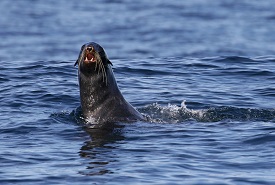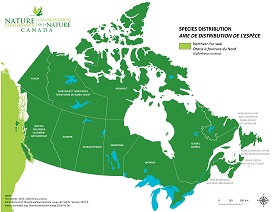
Northern fur seal off the coast of Vancouver Island (Photo by Cameron Deckert)
Northern fur seal
Found along the coasts of Japan in the western Pacific, across the Bering Sea linking Russia to North America and as far south as California, the northern fur seal is the most widely distributed and abundant seal in the north Pacific Ocean.
What does it look like?
The northern fur seal exhibits extreme physical difference between males and females of the species. Male seals can be measure as long as two metres and weigh 100 to 200 kilograms, while females average 1.3 metres in length and weigh 35 to 45 kilograms.
The species is characterized by a thick double-layered coat of fur, with darker guard hairs that molt in summer to reveal cream-coloured underfur. The female's outer fur is grey-brown in colour, while males can range in colour from black to reddish brown.
Where does it live?
Northern fur seals are highly migratory and spend most of their life at sea. From June to November, they give birth to their pups and breed on six islands in Alaska and Russia. They then spend the remainder of the year foraging in offshore waters as far south as California.
Within its Canadian range, northern fur seals can be found in waters 20 to 150 kilometres off the BC coast. Canadian waters provide an important foraging ground, particularly for pregnant females returning to their rookeries in Alaska from January to June. Between 300,000 and 500,000 northern fur seals pass through Canadian waters on their migration. Northern fur seals have been observed resting on the shore in BC.
What is this species’ conservation status?
Within Canada, northern fur seals are assessed as threatened by the Committee on the Status of Endangered Wildlife in Canada. This hints at a larger global decrease in the species’ population, as recognized by the IUCN Red List, where the species as a whole is listed as vulnerable. Once widely hunted, and on the verge of extinction, northern fur seals have made a remarkable recovery. Their main threats today are changes in food availability from unsustainable fisheries and climate change.
What is NCC doing to protect habitat for this species?
The Nature Conservancy of Canada (NCC) works to protect habitat throughout the islands and waterways of BC’s coast. These conservation efforts help ensure heathy coastal ecosystems and fish stock, such as pacific salmon, which northern fur seals feed on.





